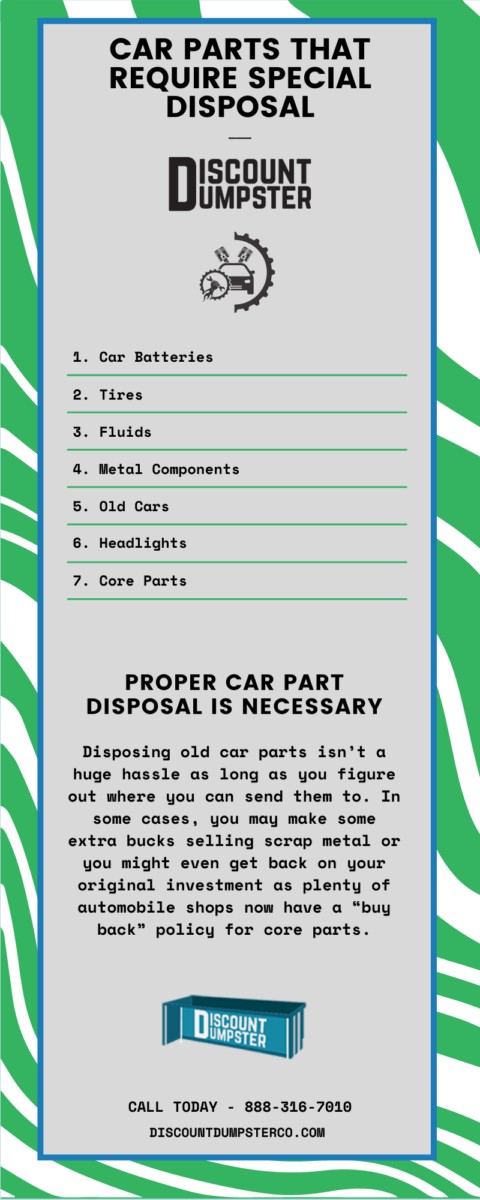Dealing with old car parts after repairs or a vehicle upgrade can be a challenge. Knowing how to dispose of these parts properly is not only essential for decluttering but also for environmental responsibility. This guide provides comprehensive information on where to dispose of various car parts, ensuring proper handling and recycling.
Options for Disposing of Old Car Parts
Several options exist for getting rid of old car parts, ranging from recycling to reselling. The best method depends on the type of part and local regulations.
1. Auto Parts Stores
Many auto parts stores accept used car parts, particularly those with core value like batteries, starters, and alternators. Some offer a “core charge” refund when you return the old part upon purchasing a new one. This incentivizes recycling and ensures proper disposal of potentially hazardous materials.
 Auto parts store with car batteries.
Auto parts store with car batteries.
2. Scrap Yards/Salvage Yards
Scrap yards or salvage yards are excellent options for disposing of metal car parts, such as engine blocks, transmissions, and body panels. They buy these parts for their scrap metal value, often paying by weight. This keeps metal out of landfills and provides raw materials for new products.
3. Recycling Centers
Recycling centers accept a variety of car parts, including tires, batteries, and some fluids. Check with your local recycling center to determine what specific items they handle and any requirements for preparing the parts for drop-off. They often have designated areas for hazardous waste disposal.
4. Hazardous Waste Disposal Facilities
Certain car parts contain hazardous materials, such as fluids (oil, coolant, brake fluid), batteries, and mercury switches. These items require specialized disposal at designated hazardous waste facilities. Improper disposal can contaminate soil and water sources. Your local municipality can provide information on nearby facilities.
5. Online Marketplaces
For parts still in usable condition, consider selling them through online marketplaces like eBay or Craigslist. This provides an opportunity for others to reuse functional parts, extending their lifespan and reducing waste. Be sure to accurately describe the condition of the part and provide clear photos.
6. Donations
Some charities or vocational schools may accept used car parts for training purposes or to repair vehicles for those in need. This option offers a way to repurpose parts and contribute to a good cause.
Specific Car Part Disposal Guide
This table outlines disposal options for common car parts:
| Car Part | Disposal Options |
|---|---|
| Battery | Auto parts stores, recycling centers, hazardous waste facilities |
| Tires | Tire shops, recycling centers, some landfills |
| Fluids (oil, coolant, brake fluid) | Auto parts stores (some), hazardous waste facilities |
| Metal Parts | Scrap yards, salvage yards, recycling centers |
| Engine/Transmission | Scrap yards, salvage yards, specialized auto recyclers |
| Headlights | Check local regulations; may be disposed of with regular trash in some areas |
| Core Parts (alternators, starters) | Auto parts stores (often with core charge refund) |
The Importance of Proper Car Part Disposal
Proper car part disposal is vital for several reasons:
- Environmental Protection: Recycling and proper disposal prevent hazardous materials from polluting the environment.
- Resource Conservation: Recycling metals and other materials reduces the need to extract virgin resources.
- Landfill Reduction: Diverting car parts from landfills extends their lifespan and conserves valuable space.
- Compliance with Regulations: Disposing of hazardous waste properly ensures compliance with local and national regulations.
By understanding Where To Get Rid Of Old Car Parts, you can contribute to a cleaner, more sustainable future. Choose the most appropriate disposal method for each part to maximize resource recovery and minimize environmental impact.

